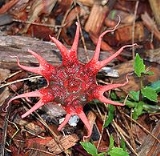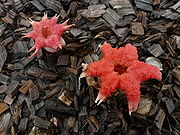
Aseroë rubra
Encyclopedia
Aseroe rubra, commonly known as the anemone stinkhorn, sea anemone fungus and starfish fungus, is a common and widespread basidiomycete
fungus
recognizable for its foul odour of carrion and its sea anemone
shape when mature. Found in gardens on mulch
and in grassy areas, it resembles a red star-shaped structure covered in brownish slime on a white stalk. It attracts flies, which spread its spore
s.
and named by the French botanist Jacques Labillardière
. The scientific name is derived from the Ancient Greek
words Asē/αση 'disgust' and roē/ροη 'juice', and the Latin
ruber 'red'. It is a member of the stinkhorn family Phallaceae though has been placed by some mycologists in a separate family Clathraceae. Like them it bears its spores in a brownish slime which smells of feces or carrion and attracts flies, which spread the spores.
, which smells of rotting meat. There is a cup-shaped volva
at the base that is the remnants of the original egg.
 This fairly common fungus is widely distributed in Australia from southeastern Queensland
This fairly common fungus is widely distributed in Australia from southeastern Queensland
through New South Wales
and eastern Victoria
and Tasmania. It is also found across the islands in the Pacific Ocean
. A saprotroph, it is found on decomposing plant matter as well as on woodchips and mulch and is common in gardens and amenities plantings. It also occurs in alpine grasslands and woodlands.
From its natural habitat it appears to have travelled to other parts of the world in garden or soil products; it was recorded growing on soil transported from Australia in a glasshouse in Kew Gardens in 1829 and later in California
in North America
. Transport in garden or soil products does not explain its presence on remote Pacific islands or its occurrence in South Africa
in localities remote from any garden. These unexplained localities cast doubt on the assumption that the species was spread from Australia and New Zealand by the agency of man.
Basidiomycota
Basidiomycota is one of two large phyla that, together with the Ascomycota, comprise the subkingdom Dikarya within the Kingdom Fungi...
fungus
Fungus
A fungus is a member of a large group of eukaryotic organisms that includes microorganisms such as yeasts and molds , as well as the more familiar mushrooms. These organisms are classified as a kingdom, Fungi, which is separate from plants, animals, and bacteria...
recognizable for its foul odour of carrion and its sea anemone
Sea anemone
Sea anemones are a group of water-dwelling, predatory animals of the order Actiniaria; they are named after the anemone, a terrestrial flower. Sea anemones are classified in the phylum Cnidaria, class Anthozoa, subclass Zoantharia. Anthozoa often have large polyps that allow for digestion of larger...
shape when mature. Found in gardens on mulch
Mulch
In agriculture and gardening, is a protective cover placed over the soil to retain moisture, reduce erosion, provide nutrients, and suppress weed growth and seed germination. Mulching in gardens and landscaping mimics the leaf cover that is found on forest floors....
and in grassy areas, it resembles a red star-shaped structure covered in brownish slime on a white stalk. It attracts flies, which spread its spore
Spore
In biology, a spore is a reproductive structure that is adapted for dispersal and surviving for extended periods of time in unfavorable conditions. Spores form part of the life cycles of many bacteria, plants, algae, fungi and some protozoa. According to scientist Dr...
s.
Taxonomy
The first native Australian fungus to be formally described, Aseroe rubra was collected in 1800 in southern TasmaniaTasmania
Tasmania is an Australian island and state. It is south of the continent, separated by Bass Strait. The state includes the island of Tasmania—the 26th largest island in the world—and the surrounding islands. The state has a population of 507,626 , of whom almost half reside in the greater Hobart...
and named by the French botanist Jacques Labillardière
Jacques Labillardière
Jacques-Julien Houtou de Labillardière was a French naturalist noted for his descriptions of the flora of Australia. Labillardière was a member of a voyage in search of the La Pérouse expedition...
. The scientific name is derived from the Ancient Greek
Ancient Greek
Ancient Greek is the stage of the Greek language in the periods spanning the times c. 9th–6th centuries BC, , c. 5th–4th centuries BC , and the c. 3rd century BC – 6th century AD of ancient Greece and the ancient world; being predated in the 2nd millennium BC by Mycenaean Greek...
words Asē/αση 'disgust' and roē/ροη 'juice', and the Latin
Latin
Latin is an Italic language originally spoken in Latium and Ancient Rome. It, along with most European languages, is a descendant of the ancient Proto-Indo-European language. Although it is considered a dead language, a number of scholars and members of the Christian clergy speak it fluently, and...
ruber 'red'. It is a member of the stinkhorn family Phallaceae though has been placed by some mycologists in a separate family Clathraceae. Like them it bears its spores in a brownish slime which smells of feces or carrion and attracts flies, which spread the spores.
Description
It begins as a partly buried whitish egg-shaped structure 3 cm (1¼ in) in diameter, which bursts open as a hollow white stalk with reddish arms erupts and grows to a height of 10 cm (4 in). It matures into a reddish star-shaped structure with six to ten arms up to 3.5 cm (1½ in) long radiating from the central area. These arms are bifid (deeply divided into two limbs). The top of the fungus is covered with dark olive-brown slime or glebaGleba
Gleba is the fleshy spore-bearing inner mass of fungi such as the puffball or stinkhorn.The gleba is a solid mass of spores, generated within an enclosed area within the sporocarp. The continuous maturity of the sporogenous cells leave the spores behind as a powdery mass that can be easily blown away...
, which smells of rotting meat. There is a cup-shaped volva
Volva (mycology)
The volva is a mycological term to describe a cup-like structure at the base of a mushroom that is a remnant of the universal veil. This macrofeature is important in wild mushroom identification due to it being an easily observed, taxonomically significant feature which frequently signifies a...
at the base that is the remnants of the original egg.
Distribution and habitat

Queensland
Queensland is a state of Australia, occupying the north-eastern section of the mainland continent. It is bordered by the Northern Territory, South Australia and New South Wales to the west, south-west and south respectively. To the east, Queensland is bordered by the Coral Sea and Pacific Ocean...
through New South Wales
New South Wales
New South Wales is a state of :Australia, located in the east of the country. It is bordered by Queensland, Victoria and South Australia to the north, south and west respectively. To the east, the state is bordered by the Tasman Sea, which forms part of the Pacific Ocean. New South Wales...
and eastern Victoria
Victoria (Australia)
Victoria is the second most populous state in Australia. Geographically the smallest mainland state, Victoria is bordered by New South Wales, South Australia, and Tasmania on Boundary Islet to the north, west and south respectively....
and Tasmania. It is also found across the islands in the Pacific Ocean
Pacific Ocean
The Pacific Ocean is the largest of the Earth's oceanic divisions. It extends from the Arctic in the north to the Southern Ocean in the south, bounded by Asia and Australia in the west, and the Americas in the east.At 165.2 million square kilometres in area, this largest division of the World...
. A saprotroph, it is found on decomposing plant matter as well as on woodchips and mulch and is common in gardens and amenities plantings. It also occurs in alpine grasslands and woodlands.
From its natural habitat it appears to have travelled to other parts of the world in garden or soil products; it was recorded growing on soil transported from Australia in a glasshouse in Kew Gardens in 1829 and later in California
California
California is a state located on the West Coast of the United States. It is by far the most populous U.S. state, and the third-largest by land area...
in North America
North America
North America is a continent wholly within the Northern Hemisphere and almost wholly within the Western Hemisphere. It is also considered a northern subcontinent of the Americas...
. Transport in garden or soil products does not explain its presence on remote Pacific islands or its occurrence in South Africa
South Africa
The Republic of South Africa is a country in southern Africa. Located at the southern tip of Africa, it is divided into nine provinces, with of coastline on the Atlantic and Indian oceans...
in localities remote from any garden. These unexplained localities cast doubt on the assumption that the species was spread from Australia and New Zealand by the agency of man.

